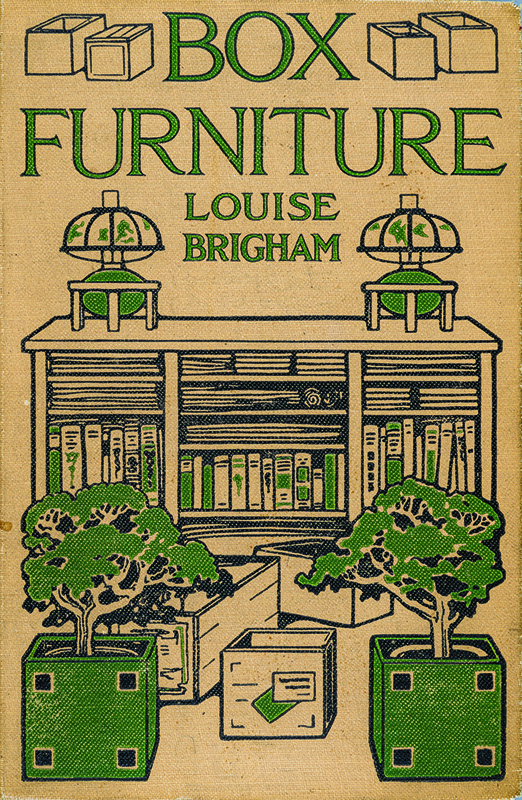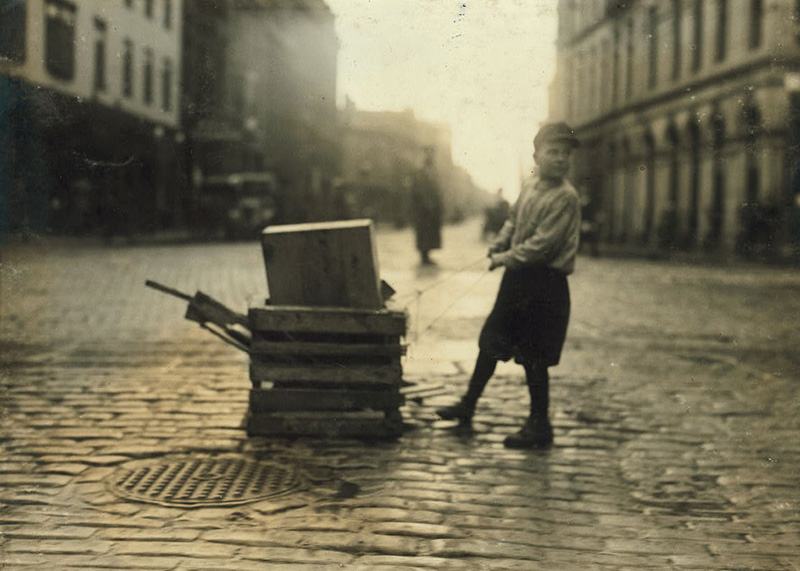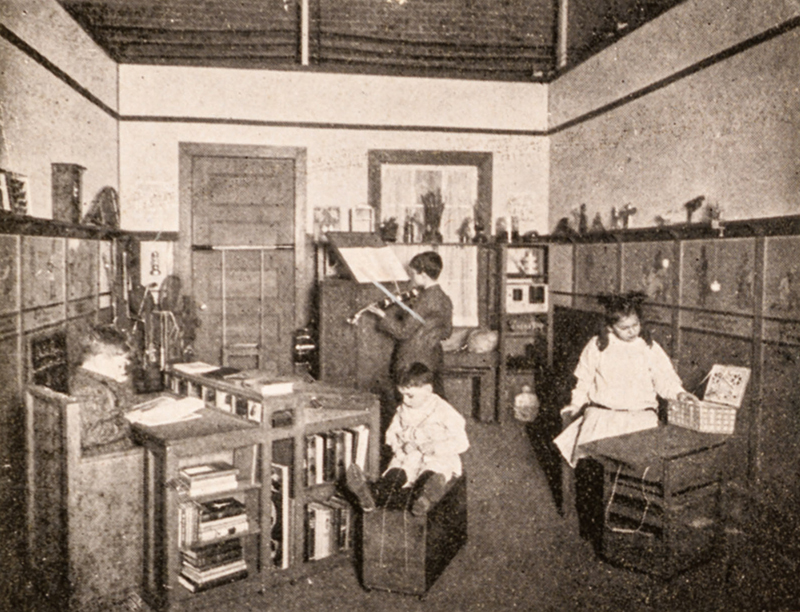Louise Brigham’s Box Furniture and the Long History of Democratic Design and Creative Reuse
by Jena Gilbert-Merrill
In 1909, a little-known artist and social reformer named Louise Brigham published Box Furniture: How to Make a Hundred Useful Articles for the Home (figure 1), a collection of instructions for producing simple, modular furniture from repurposed wooden packing crates.
Although this text sought to demonstrate the latent possibilities of cast-off materials, the impact of Box Furniture extended beyond the cover. It can also be understood as an advice book on thrift, home decoration, and domesticity, topics at the heart of Brigham’s experiences with the Home Thrift Association, which offered carpentry workshops aimed at skilling and empowering immigrant and working-class people by involving children of these communities (figures 2 and 3). With this book and the social reform project in which it was situated, Louise Brigham sought to cultivate comfort and convenience in the builders of box furniture while also empowering them to be good citizens and creative homemakers.1 Box Furniture defies strict categorization, and it was at once a product of its time and ahead of it.
Box Furniture presents a cohesive vision of Arts and Crafts style and combines its modular, geometric, multipurpose design with a handcrafted materiality that was meant to be accessible to anyone willing to wield a hammer and nail. For Brigham, making box furniture gave form to a utopian vision through which life could be improved through craftwork and community. As a social project with a deeply aesthetic focus and an aesthetic project that is rooted in social reform, Box Furniture sits at the nexus of the Arts and Crafts Movement, Progressivism, and other reform efforts of the day.
The socioeconomic, cultural, political, and aesthetic landscape of the late 19th and early 20th centuries was complexly interwoven and in flux due to global modernization, industrialization, and urbanization. Reformers responded to the public welfare concerns that escalated as a result of these changes, with Jacob Riis, for example, taking on the specter of urban tenement life in How the Other Half Lives (1890), a text which influenced Brigham. Where Progressives advocated for reforms to address the material conditions of urban poverty, and proponents of the Arts and Crafts Movement centered art and design in their solutions to the same problems, Box Furniture brought these seemingly disparate efforts together, uniting social and aesthetic reform and centering the questions of labor, domesticity, and democracy.
To devise her system of box furnishings, Brigham drew upon her experience in the settlement house movement—which brought working-class, immigrant populations and upper-class American reformers into reciprocal relationships of living and learning —as well as the artistic training she received at the Pratt Institute and under Josef Hoffman and Charles Rennie Mackintosh. A devoted social reformer, educator, and artist, she also participated in exhibitions organized around Progressive issues, displaying model rooms furnished with fashionable, functional, and accessible box furnishings (figure 4).
The interweaving of aesthetic, social, educational, and domestic reform that Brigham achieved with Box Furniture activated the Arts and Crafts Movement’s call for democratic design. Brigham offered socially, politically, and materially marginalized people the opportunity to create beautiful, useful, and affordable objects; to find fulfillment through handwork; and to craft for themselves a sense of comfort, place, and belonging. She helped to widen the pathway into this movement by reframing the everyday, working-class practices of “making do” and “junk collecting” in newly beneficial and aestheticized terms. The thoughtfully designed craft of the Arts and Crafts Movement placed these furnishings out of reach of all but the wealthiest citizens, but Box Furniture brought handcraft to an affordable and accessible level.
Even though examples of box furniture have seemingly not survived, and while Brigham’s work is little-known today, she was recognized, praised, and respected in her time, teaching, publishing, and garnering attention widely. She did not invent the concept of creative reuse, but her unique framing of this practice was reflective of her era and place and generated ripples over time. There are many instances similar in spirit to Brigham’s aesthetic, material, and social vision: furniture made from scrap lumber in Japanese internment camps and on Farm Security Administration projects during the Great Depression; by artists of the Studio Craft movement, such as Wharton Esherick; in the counterculture movement of the 1970s; and in contemporary DIY practice. Furthermore, the environmental implications of the materials we interact with and the waste we produce on a daily basis today cast Box Furniture in a new light. While the materials in our trash-scapes today differ from those of the early 20th century, and our planet is plagued with single-use plastics that stubbornly linger and strangle our world, can Box Furniture serve as a model for thinking about waste and creative reuse to meet today’s challenges?
While relatively unknown and understudied, Louise Brigham’s Box Furniture represents a major contribution at the intersection of the Arts and Crafts Movement and the Progressive Era, to the various dimensions of aesthetic, social, and domestic reform and innovation that defined the early 20th century and have continued relevance in the present day.
- Alicia Potter, “The Upward Trend: Home Creating, or the Strengthening of a Nation’s Center.” The New Age Magazine 28, no. 1 (January 1913): 330.
Jena Gilbert-Merrill is the Grants Writer at the Center for Craft and was a Lois F. McNeil Fellow at the Winterthur Program in American Material Culture, University of Delaware. Watch the Emerging Scholars Colloquium featuring her lecture on this topic in The Decorative Arts Trust Bulletin.
A print version of this article was published in The Magazine of the Decorative Arts Trust, one of our most popular member benefits. Join today!




